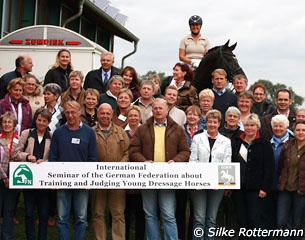
In the wake of its succes two years ago the German equestrian federation held an FEI endorsed international dressage seminar for judges, trainers, stewards, veterinarians and all interested on 3 - 6 September 2011 at the DOKR German Equestrian Training Centre in Warendorf. About 75 participants from 15 different countries attended the 4-day-seminar which brought theory and practise together with the support of renowned trainers and riders.
Two Days of Seminar during Bundeschampionate
The seminar attendants were traated to masterly commentary by German judge Angelika Frömming via earphone during the 4-year-old riding stallions' class and Finals of the 6-year-old dressage horses on Saturday and the Finals of the 5-year-old dressage horses on Sunday. On Saturday evening the attendees gathered in the seminar hall for discussions on the shown rides, which were moderated by judges Dr. Dietrich Plewa and Dr. Dieter Schüle.
It was not really surprising that the tight result between the 6-year old winner Benicio and the runner-up Damon Jerome H on Saturday caused much discussion as the judges had favoured the spectacular instead of correctness. The first placed riders themselves were present to report on their rides and horses and to answer questions from the audience.
After two days of high class action during Germany’s young horses talent-show everybody met in the seminar hall on Monday morning for a midmorning of different lectures focusing on breeding and training the dressage horse.
Chris Hector Asks for a Global Perspective on Breeding Dressage Horses
German Equestrian Federation Secretary General and Chairman of the Board, Sönke Lauterbach, welcomed the attendees from all over the world before Chris Hector, chief editor of Australia’s leading equestrian magazine “The Horse Magazine” and a well known breeding expert, started the series of lectures with his talk titled “Breeding Dressage Horses – a global perspective.”
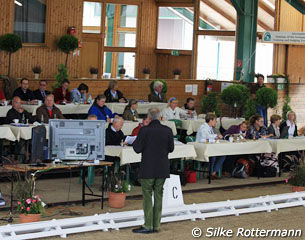 Hector, who for more than 10 years is an annual visitor of the Bundeschampionate, expressed his gratitude to Christoph Hess for being part of an exclusive group of lecturers and for receiving the opportunity to speak in front of such an audience.
Hector, who for more than 10 years is an annual visitor of the Bundeschampionate, expressed his gratitude to Christoph Hess for being part of an exclusive group of lecturers and for receiving the opportunity to speak in front of such an audience.
In his presentation Hector portrayed the evolution of dressage horse breeding from its early days to the present and revealed the decisive factors which led to the recent high standard.
He made conscious that in the “old days” everywhere in Europe the breeding system worked similarly by providing state owned stallions on different regional stations to the breeders. Local breeders would more or less choose the stationed stallions for their mares with no frozen semen invented yet and transport possibilities almost non-existent. The aim of breeding back then had not been a specialised horse, but a nice allrounder which could compete on the weekends and be used in front of the plough for the rest of the week.
Hector emphasised that the idea to breed a specialised dressage horse is comparatively recent and that the first of the European countries which made a successful attempt to breed specialised dressage horses had been Sweden, where chestnut stallion Gaspari was a kind of pioneer by being the first breeding stallion also competing internationally up to Olympic Games.
In Germany the trend to specialise the breeds could be observed from the early 1970s onwards. The 1971 born Hanoverian Woermann, sire of Wenzel and World Cup and grandsire of Warkant and Weltmeyer, was one of the first stallions used for the aim of producing dressage horses. According to Hector Donnerhall, born 1981, and Florestan followed this trend in Oldenburg and Westfalia.
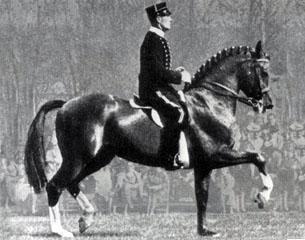 The Australian journalist not only focused on the progress of the most famous German breeding areas, but also distinguished the undeniable influence of thoroughbred and Trakehner blood.
The Australian journalist not only focused on the progress of the most famous German breeding areas, but also distinguished the undeniable influence of thoroughbred and Trakehner blood.
The latter being the only one of the German warmblood breeds which never focused on producing horses for the agricultural sector. To underline this Hector showed a stunning picture of the 1936 Olympic gold medal horse Kronos (a black Trakehner gelding by Carol x Larifari) whose beauty and type were far ahead of his time.
”The Trakehner continued to play am important role in dressage breeding," Hector claimed. The reason why we still don’t have more Trakehners excelling at the highest dressage levels such as Olympic Games is caused by the fact that “perhaps because in the 1950s and 1960s the Trakehner breeders became fixated on breeding the prettiest of the prettiest, so the worth of the Trakehner blood has been more evident when out-crossed to produce greater athleticism.” Hector referred to the Hanoverian Weltmeyer whose dam is a grandchild of the legendary Trakehner Abglanz as an example fur such an outcross. He also pointed out that 3 of the 5 best Dutch dressage horses of 2010 were sired by Trakehners.
Similarly to the Trakehners also thoroughbreds had a decisive influence on breeding the modern dressage horse. The Hanoverian dressage horse is a good example: “The emergence of it was greatly aided by the visionary Hans-Joachim Köhler. He liked horses with ‘blood’ and to be selected for his auction a good dash of thoroughbred was an advantage.” While Köhler was a trendsetter for sure, the usage of thoroughbred blood in Hanoverian breeding nowadays has changed in such a way that “while the percentage of horses by full-blood or half-blood sires has diminished, the percentage of thoroughbred blood in the population has increased.”
Hector indicated that Germany has to share its place in the sun with nations like The Netherlands and Denmark where “Blue Hors, founded in 1992, pushed the limits of dressage horse breeding to new heights.”
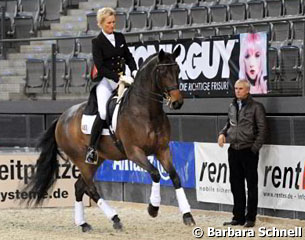 In this very interesting lecture which summarised the most important factors of dressage horse breeding over the past 50 years an aspect was mentioned that actually is easily forgotten when talking about success of certain breeds: the dressage trainer. Hector had chosen Wolfram and Brigitte Wittig who are not only Grand Prix riders, but also highly successful breeders, having currently bred 4 Grand Prix horses by Breitling out of their mare Devisa (by Diego xx) with two more standing in the starting blocks of a great dressage career.
In this very interesting lecture which summarised the most important factors of dressage horse breeding over the past 50 years an aspect was mentioned that actually is easily forgotten when talking about success of certain breeds: the dressage trainer. Hector had chosen Wolfram and Brigitte Wittig who are not only Grand Prix riders, but also highly successful breeders, having currently bred 4 Grand Prix horses by Breitling out of their mare Devisa (by Diego xx) with two more standing in the starting blocks of a great dressage career.
This outstanding success prompted Hector to ask “are these really the genes that are responsible for the success? This is the chicken and egg problem in assessing any breeding program, how to filter out the influence of the trainer.”
After 30 minutes Chris Hector came to the conclusion that the dressage breeding has lost its local intensity and that on the one hand the availability of excellent dressage sires all over Europe makes it easy to select an appropriate dressage prospect: ”Of the top 30 horses on the 2010 FEI standings we can confidently say that 26 were bred with a dressage career in mind”. On the other hand the real secret behind breeding great dressage horses is “that elusive quality of horsemanship.”
Katrin Burger: “Evolution and Requirements of Breeding and Training Dressage Horses”
Many of the participants of this seminar might have known Katrin Burger from riding talented horses like her former Bundes- and World champion FBW French Kiss, but since several years now Burger, a graduated agricultural engineer, acts as vice chairwoman of the Oldenburg breeding association. She had prepared an extensive lecture on the evolution as well as the requirements of breeding and training dressage horses, based on her own practical experiences as a dressage rider, as a member of the Oldenburg breed society and facts based on studies.
Speaking on such serious topics like Burger had chosen for her lecture holds the danger that the attention of some auditors might get lost, but in this case the united opinion was that this was one of the best lectures heard in a long time: informative and entertaining at the same time.
Burger started with the statement we already heard from Chris Hector: that the aim of breeding has changed from a multi-purpose-horse to a specialised one.
She began with presenting the selection procedure of the Oldenburg association for foals, broodmares, stallions and auction horses. Though it may not be something new, but it was still interesting to hear that most of the foals get a “premium” if they don’t have obvious defects, purely for marketing reasons as a premium foal sells better than one without this title.
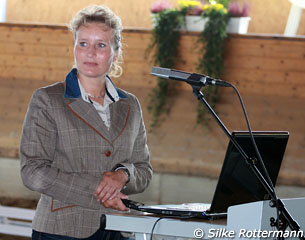 Regarding the selection of auction horses for Vechta Burger mentioned that today the majority of offered horses is between 3 and 5 years, but that buyers also want to have older and advanced horses in the auction lot, so they now start selecting 8- or 9- year-old dressage horses as well. The claim that auction horses do not become great dressage horses later on would be a prejudice. Burger showed video clips of former auction horses like Della Cavalleria and Desperado who are now renowned dressage horses. “The management of these horses after they are sold is equally important to their quality,” Burger stressed.
Regarding the selection of auction horses for Vechta Burger mentioned that today the majority of offered horses is between 3 and 5 years, but that buyers also want to have older and advanced horses in the auction lot, so they now start selecting 8- or 9- year-old dressage horses as well. The claim that auction horses do not become great dressage horses later on would be a prejudice. Burger showed video clips of former auction horses like Della Cavalleria and Desperado who are now renowned dressage horses. “The management of these horses after they are sold is equally important to their quality,” Burger stressed.
Looking at the pedigree of the auction horses one often finds the same or similar bloodlines which obviously sell the best. “We have an open studbook which means that we approve stallions with a pedigree that suits our breeding programme. Of course as a breeding association we are interested in a big variety of bloodlines.”
So why this concentration on only some bloodlines like Sandro Hit or Donnerhall? “Certain bloodlines sell extremely well and this is the reason why the breeders choose these stallions so often. But one cannot breed Grand Prix-horses, only train them. The trainer has much influence.” With this remark Burger confirmed Hector's statement on the making of a successful dressage horse.
According to Burger the breeder makes the decision where the studbook is going to, although “the breeder’s decisions are not always within the meaning of the association.” Burger showed that about 5% of all stallions cover 25% of all mares, but only 3 of these sires are 10 or older and have offspring over 4 years. 13 of the used stallions don’t have ridden offspring yet which means that there can be read little into the rideability.
”A big influence of breeders’ decisions is the market and also the aim of breeding: Do I breed for selling foals and young horses, or to get broodmares, trained or leasure horses?”
For the breeder it is of paramount importance to think of market value. In the case of horses it means to have horses sellable for good prices. “The market has changed: it’s easy to sell a top horse, but difficult to do so with an average one. The earlier a breeder can sell usually the better as he won't have a risk anymore.”
Burger elaborated vividly about which type of dressage horses a breeder should produce in our days. “The type of horse desired has changed. Today we want to have more elegant horses with long legs, being uphill, with better necks. But on the other hand also a heavier old-fashioned type sells if he has good basic gaits.”
The desired characteristics of a dressage horse were presented. Katrin Burger, a Grand Prix rider herself, started with an interesting part of the horse: the mouth. “Usually nobody talks about that, but as a rider I made the experience that a long mouth means it is soft and the horses chew more easily whereas a short mouth means rather the opposite. But also the neck has an influence on the contact with the mouth.”
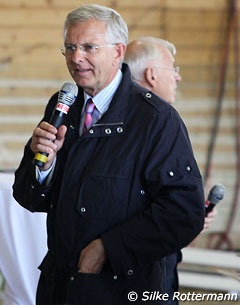 Concerning the often discussed back something in between short and long seems to be ideal as “a short back is often stronger and carries weight more easily, but tends to become tense. A long back on the other hand swings nicely and is comfortable to sit, but could cause difficulties when it comes to collection.”
Concerning the often discussed back something in between short and long seems to be ideal as “a short back is often stronger and carries weight more easily, but tends to become tense. A long back on the other hand swings nicely and is comfortable to sit, but could cause difficulties when it comes to collection.”
A similar quandary exists with the conformation of the hind legs: a more straight hind leg has more pushing and a more angled one more carrying ability. Also the way a horse carries its tail betrays a lot: back problems, tension or relaxation and it also has a visual effect.
Enormous improvements could be made regarding the rideability which turns out to be an important factor when it comes to selling the horse. For Katrin Burger “the most important factors are character and mind of a horse. It needs to have the will to work to achieve something.”
Burger warned the audience not only to look for big movements “as they are no guarantee for the Grand Prix. There are several examples of successful Grand Prix horses lacking big gaits.” She made aware that for example many only look for overtrack in the walk. “Most important is the clear 4 beat rhythm and this can be threatened by too much overtrack. Also it is difficult to collect such horses or to make transitions from walk to piaffe later on.”
There was lots of applause after Burger had finished her lecture and only one question from the audience. How does the licensing panel handles chips revealed by x- rays. “It’s not easy with chips because when I have for example the very best stallion, but he has two chips, what to do? Nowadays it’s easy to remove chips, but if a stallion has one in the stifle he’s immediately out.”
Martin Plewa: “The nature of the horse and the Consequences Regarding the Training and Equipment”
At first look some may have been puzzled by the title of Martin Plewa's lecture. Shouldn’t this topic be a familiar and well known one to all present in the seminar hall of the DOKR? Unfortunately though if one looks at the warm-up rings from the local to the international dressage show this topic is more important than ever and it is a fallacy to believe certain things, even though well known facts, are practised by every rider.
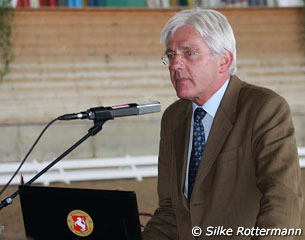 Martin Plewa, the former long time German national coach for eventing and head of the Westfalian Riding School in nearby Münster, brought back to mind that whatever we do with horses we have to take into account their nature and natural abilities.
Martin Plewa, the former long time German national coach for eventing and head of the Westfalian Riding School in nearby Münster, brought back to mind that whatever we do with horses we have to take into account their nature and natural abilities.
He opened his presentation with the assessment “Riding is more than just loving horses, it means having knowledge, for example about the behaviour of horses. Even though the horse is now domesticated for ten thousands of years and despite considerable breeding influences today’s horses are still flight and gregarious animals. The signs which constitute the nature of a horse are not captured by breeding selection and exist in all races unchanged.”
In the following Plewa dealt with how the senses of the horse work and which consequences arise from it for the riding and training of horses.
He brought some essential aspects to mind:
- Horses have a brilliant memory and they are not born with a bad behaviour which is only a reaction to the misbehaviour it has experienced by humans.
- In keeping sport horses the nature of the horse is not allowed to be forgotten. It is essential for a horse as a free herd animal has the opportunity to move freely every day in a field or at least in a paddock.
- In freedom horses are constantly looking for food so we should offer our horses permanent access to water as well as roughage or grass.
- Many of the lameness and health problems horses show today are a result of not respecting these natural needs enough
”Very strong contact and/ or a tight noseband do not allow the horse to move the tongue. Also we have to aware of failure using the double bridle. Very strong contact leads to a blue tongue, the interruption of the blood circulation. This is an abuse and therefore not acceptable.”
Plewa then referred to the traditional riding system in Germany, based on the famous “training scale” of which each single aspect can be explained by the horse’s nature, giving the following remarks:
- If you try to gain more ground in extensions the long neck is essential as it allows the horse to bring its hind legs more forward towards the centre of gravity. Riding extensions with a short neck is against the nature of the horse.
- There is increasingly the look for expression in extensions. If judges write down in the protocol the horse should show more expression they animate the riders to ride incorrectly.
- To develop carrying power a horse needs muscle power which in nature is only asked for during short periods of times like in tight turns. Hence collected work is demanding and in longer duration may be exhausting for the horse so it should be trained gradually and sensitively.
- Proper training outside an indoor school or a dressage arena has the huge advantage to establish a good and well balanced mental and physical constitution for all sport horses.
In his lecture which was visualised by several appropriate pictures Martin Plewa came to the conclusion that “the consideration of the nature of the horse must be the ethical basis for our way how to deal with horses.”
Peter Stadler: “Schooling of the Riding Horse in consideration of Health Aspects – in the Past and Now”
Prof. Dr. Stadler is a veterinary surgeon specialised on horses at the very renowned Veterinary University of Hanover. In his presentation he travelled through the ages, looking back on the attitude of horsemen in former times, and revealed that wrong approaches existed back then and today. Stadler explained the consequences for the horse's health.
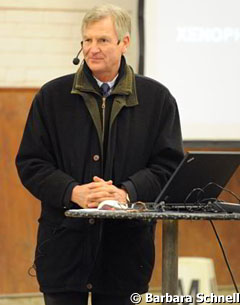 Stadler started citing Xenophon, a Greek who is considered to be the first rider writing down his knowledge in a manual (“About the Art of Riding”). Having been a cavalry rider Xenophon has as main aim to train and ride horses so they stay healthy and could serve as long as possible.
Stadler started citing Xenophon, a Greek who is considered to be the first rider writing down his knowledge in a manual (“About the Art of Riding”). Having been a cavalry rider Xenophon has as main aim to train and ride horses so they stay healthy and could serve as long as possible.
In the Middle Ages there was an ugly treatment of horses. Stadler showed a picture of a rider pulling the nose of his horse to its breast. Ironically few riders today seem to have fallen back to this dark age as Stadler put a recent picture of a rollkur horse in the warm-up ring right next to the one of the Middle Ages.
During the Age of Enlightment a change of paradigm took place with the Frenchman Francois Rochichon de la Guérinière whose famous book “Ecole de Cavalerie” was first published in 1733. Stadler distinguished that Guérinière was the first who dedicated a whole part of his book to the health aspect and that he already warned for impatient trainers who trained horses too quickly and in doing so ruined them.
The 19th century saw very different approaches to dressage: From Francois Baucher’s impulsion-lacking and flexion-loaden 1st method to the extremely high elevation of James Fillis, a successor Baucher’s or the hyperflexion method of the German Emperor’s stablemaster Paul Plinzer. Citing Otto de la Croix Stadler remarked that “the riding world remained clueless who is right.”
While the equestrian world back then might had been clueless which approach was the right or best one, from today’s point of view it is without question that the classical approach is the horse-friendliest. This approach became popular in Germany within the cavalry at the beginning of the 20th century. Stadler pointed out that the introduction of the HDV 12 (German cavalry manual) defined the goal and principles of classical dressage which are “to preserve and promote the horse’s natural abilities” and served as the basis for developing the German FN guidelines for riding and driving.
He went on explaining that the goal of dressage is to get “a self-carriage with a natural muscle tone” which is possible if a horse is correctly worked from rear to front, gaining carrying power. In contrary the what Stadler called “modern riding style” or generally known as rollkur training, this “is a significant deviation from the natural head-neck-carriage which a horse in nature would only take in for short periods to drive away insects or to scratch. It leads to a dysfunctional muscle tone and poorly co-ordinated movements.”
The suppleness of a horse is essential for Stadler: “Once obtained by training and repetition it is always achievable, but if a horse doesn’t learn it at a young age it will never learn it later on.” He explained in this context that the “modern riding style” by contrast leads to tight necks and uptight horses, ugly pictures and poor piaffes and passages, but also to health problems.
Of course these can also be a result of premature training of which the risks are even higher since the young horse classes have been established. Stadler showed two interesting pictures in comparison: The three-year-old Trakehner Herder ridden by Felix Bürkner, once one of Germany’s top dressage combinations before World War II, and a three-year-old Bundeschampion of 2009. The latter almost looking like a ready-made dressage horse, very well muscled, whereas Herder looked bony and lacked muscles.
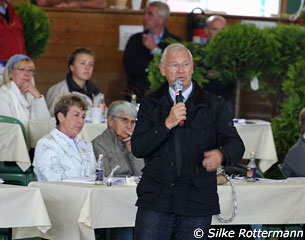 ”It has been noted that extravagant moving young horses prepared for sales or young horses classes have a high incidence of hind proximal suspensory desmitis,” Stadler cited after Dyson. More typical health problems of dressage horses are such of the suspensory ligament, the tarsal joint and back pain.
”It has been noted that extravagant moving young horses prepared for sales or young horses classes have a high incidence of hind proximal suspensory desmitis,” Stadler cited after Dyson. More typical health problems of dressage horses are such of the suspensory ligament, the tarsal joint and back pain.
Even so the conditions to keep, feed and treat horses have improved tremendously over the past 100 years the life expectancy of horses has diminished in the course of time. During peace times the cavalry horses were in service averagely until 15, but the warmbloods of today only reach an average age between 8 and 10. The cause of this should be food for thought!
Stadler came to the conclusion that the solution to these problems would be to reduce the discrepancy between the existing rules and the realities in competition, referring to Odberg and Boussou; “Although officially the rules require lightness, in modern dressage competitions sins against it are rarely penalised.”
For the vet the ethical guidelines released by the FN are of paramount importance, saying “the physical and psychological health of the horse must take priority regardless of its use.” He finished his lecture showing a picture of the impressive entrance door of the legendary School of Versailles where in the 18th century the art of riding was brought to highest highs by sensitive French riding masters. Above this door one can read: “Where art ends, violence begins.”
Read Also: Part II of 2011 FEI Young Horse Seminar and Judges Course with training demonstrations and lectures on day 4 of the seminar
Text and Photos by Silke Rottermann/Barbara Schnell © Eurodressage
Related Links
FEI Endorsed Young Horse Seminar and Judges Course to be Held at 2011 Bundeschampionate
Strengthening Dressage Sport Through Open Discussion at 2011 German Dressage Judges Seminar